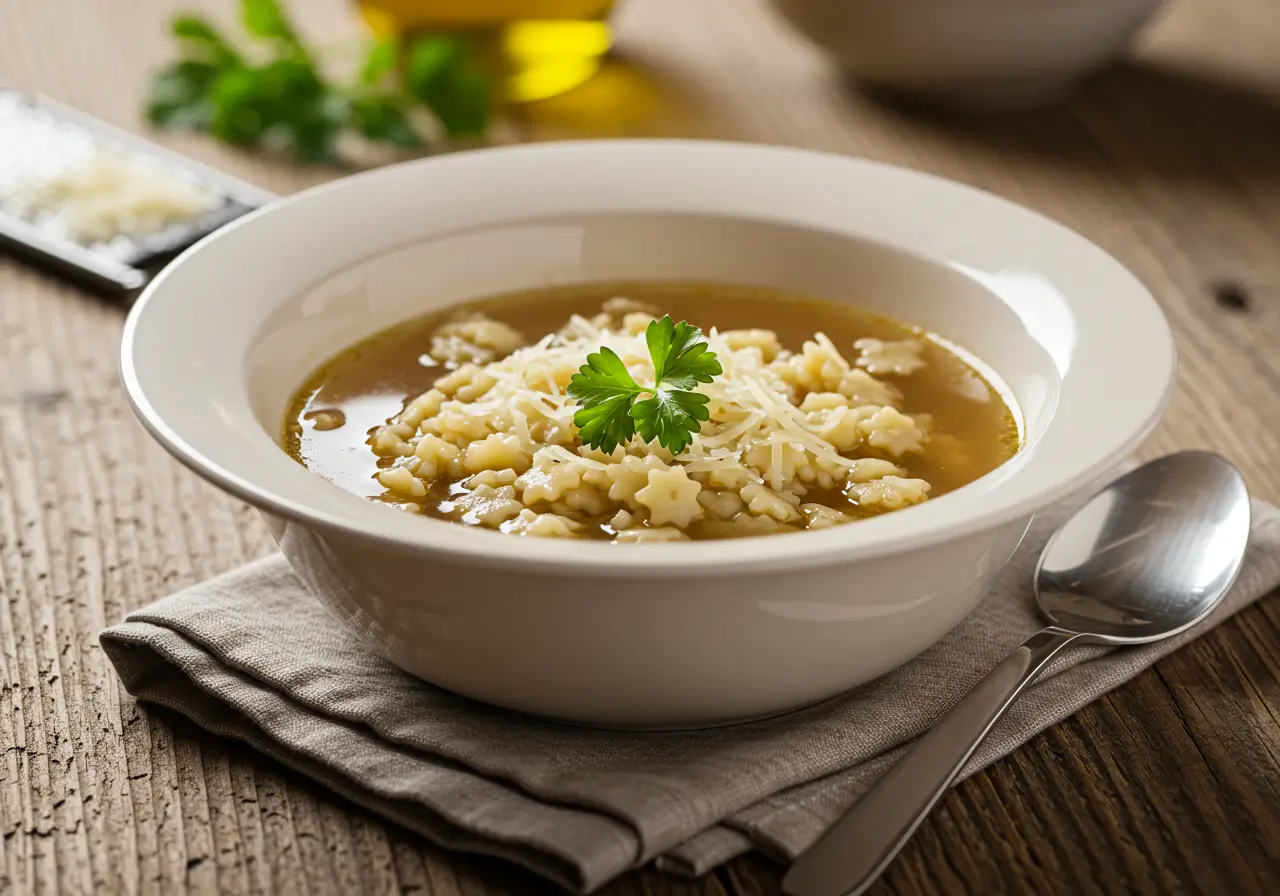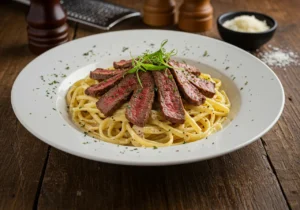If you’re seeking a dish that wraps you in warmth and nostalgia, look no further. This article delves into the heart of Italian comfort food with a comprehensive guide to the pastina recipe. From its humble beginnings to its cherished place in kitchens worldwide, we’ll explore the essence of this beloved dish. Whether you’re under the weather or simply craving a taste of home, pastina offers a simple yet satisfying solution. Join us as we uncover the ingredients, preparation methods, variations, and cultural significance of this timeless classic.
Introduction to Pastina: Italy’s Beloved Comfort Dish
What Is Pastina?
Pastina, translating to “little pasta” in Italian, encompasses a variety of tiny pasta shapes, such as stelline (little stars), acini di pepe, and orzo. These minuscule pastas serve as the foundation for a dish that has comforted generations. Typically cooked in broth and enriched with butter and cheese, pastina is more than just a meal—it’s a soothing experience. Its simplicity and warmth have made it a staple in Italian households, especially during times of illness or cold weather. The dish’s gentle texture and mild flavors make it particularly appealing to children and those seeking solace in a bowl.
Why Pastina Is Called “Italian Penicillin”
Affectionately dubbed Italian Penicillin, pastina has earned its reputation as a go-to remedy for the ailing. Much like chicken noodle soup in other cultures, a steaming bowl of pastina is believed to have healing properties. The combination of warm broth, tender pasta, and nourishing ingredients provides both physical comfort and emotional reassurance. It’s not uncommon for Italian grandmothers, or nonnas, to prepare pastina for loved ones feeling under the weather, reinforcing its status as a culinary cure-all. This enduring tradition underscores the dish’s role not just as sustenance, but as a symbol of care and familial love.
Essential Ingredients for the Classic Pastina Recipe
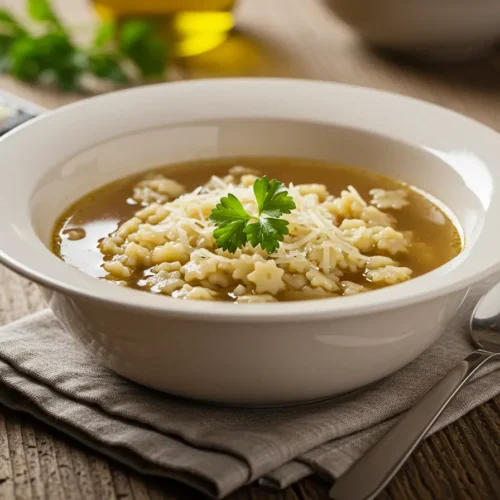
Classic Italian Pastina Recipe
Ingredients
- 1 cup pastina tiny pasta
- 3 cups chicken or vegetable broth
- 2 tablespoons unsalted butter
- 1/2 cup grated Parmesan cheese
- Salt and pepper to taste
Instructions
- In a medium saucepan, bring the broth to a gentle boil.
- Add the pastina and stir occasionally to prevent sticking.
- Cook for 4-5 minutes until the pasta is tender and most of the liquid is absorbed.
- Remove from heat and stir in the butter until melted.
- Mix in the grated Parmesan cheese until well combined.
- Season with salt and pepper to taste.
- Serve warm, garnished with additional Parmesan if desired.
Notes
Core Ingredients
Crafting a comforting pastina recipe begins with a handful of simple, wholesome ingredients: (Pastina Recipe | The Cozy Apron)
- Pastina Pasta: Tiny pasta shapes like stelline (little stars), acini di pepe, or orzo are ideal. These small shapes cook quickly and provide the desired creamy texture.
- Broth: Low-sodium chicken or vegetable broth serves as the flavorful base. Using broth instead of water enhances the dish’s depth and warmth.
- Butter: A tablespoon of unsalted butter adds richness and a silky finish.
- Parmesan Cheese: Freshly grated Parmesan infuses the dish with a savory, umami flavor.
- Egg (Optional): Stirring in a beaten egg creates a creamy, risotto-like consistency, elevating the dish’s comfort factor.
These ingredients combine to form a dish that’s both nourishing and satisfying, embodying the essence of Italian comfort food.
Optional Add-ins and Variations
To personalize your pastina recipe, consider these flavorful additions:
- Garlic: Sauté minced garlic in olive oil before adding the broth for an aromatic base.
- Vegetables: Incorporate finely chopped carrots, celery, or spinach for added nutrition and texture.
- Herbs: Fresh parsley, basil, or a sprinkle of thyme can brighten the dish.
- Alternative Cheeses: Experiment with Pecorino Romano or Asiago for a different flavor profile.
These variations allow you to tailor the dish to your taste preferences while maintaining its comforting essence.
Step-by-Step Guide to Making Traditional Pastina
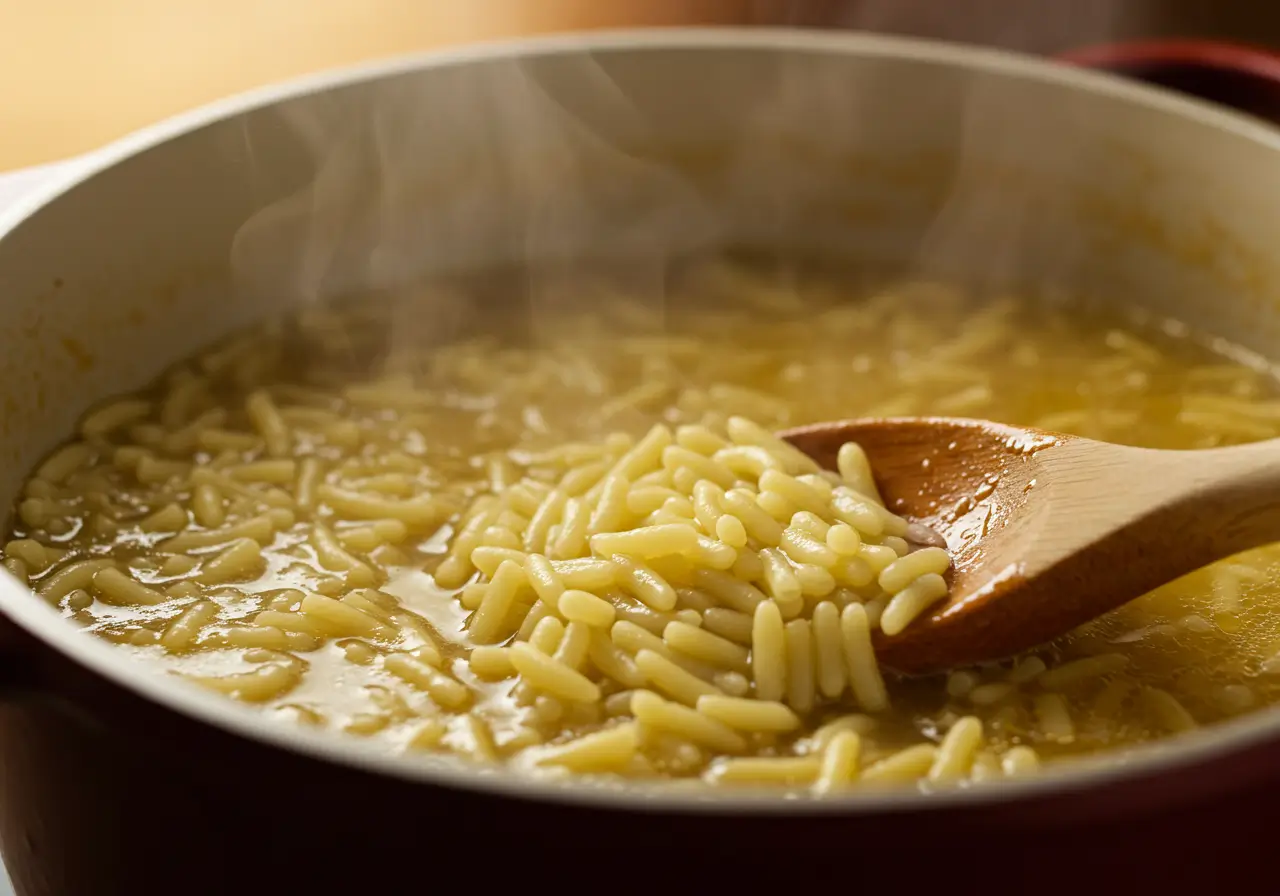
Preparing the Broth
Begin by bringing 4 cups of low-sodium chicken or vegetable broth to a gentle boil in a medium saucepan. Using broth instead of water imparts a richer flavor, enhancing the overall taste of the pastina recipe. (Pastina Recipe (Easy & Cheesy Pasta, Just 5 Ingredients) | The Kitchn)
Cooking the Pastina
Once the broth is boiling, add 1 cup of pastina pasta to the pot. Stir gently to prevent sticking. Reduce the heat to a simmer and cook for about 4-5 minutes, or until the pasta is tender and has absorbed most of the liquid. Stir occasionally to ensure even cooking and prevent clumping.
Incorporating Cheese and Butter
After the pastina has cooked, remove the saucepan from heat. Stir in 1 tablespoon of unsalted butter until melted, then add 1/4 cup of freshly grated Parmesan cheese. Mix thoroughly until the cheese is fully incorporated, resulting in a creamy, cohesive texture.
Adding the Egg (Optional)
For an extra layer of richness, you can incorporate a beaten egg. While the pastina is still hot, slowly drizzle in the beaten egg while continuously stirring. This technique creates a silky, risotto-like consistency, enhancing the dish’s comfort factor.
Serve the pastina hot, garnished with additional Parmesan cheese and a sprinkle of freshly ground black pepper, if desired. This classic preparation embodies the heartwarming qualities that make the pastina recipe a beloved staple in Italian cuisine.
Popular Variations of Pastina Recipes
Vegetable-Infused Pastina
Enhance the nutritional value of your pastina recipe by incorporating vegetables. Sauté finely chopped onions, carrots, and celery in a bit of olive oil until softened. Add these to the broth before cooking the pastina, allowing the flavors to meld. This variation not only adds depth to the dish but also provides a serving of vegetables in a comforting format.
Spicy Pastina with Calabrian Chili
For those who enjoy a bit of heat, consider adding Calabrian chili to your pastina. Sauté minced garlic and shallots in olive oil, then add a spoonful of Calabrian chili paste. Stir in the pastina and cook as usual. Finish with a generous sprinkle of Taleggio cheese for a creamy, spicy twist on the traditional pastina recipe.
Pastina Soup with Chicken
Transform your pastina into a hearty soup by adding shredded cooked chicken. Start by simmering chicken broth with diced carrots, celery, and onions until the vegetables are tender. Add the pastina and cook until al dente. Stir in the shredded chicken and heat through. This variation turns the simple pastina recipe into a satisfying meal suitable for any occasion.
These variations showcase the versatility of pastina, allowing you to adapt the dish to your preferences while maintaining its comforting essence. Whether you’re seeking a nutritious option, a spicy kick, or a hearty soup, the pastina recipe can be easily customized to suit your needs.
Cultural Significance of Pastina in Italian Households
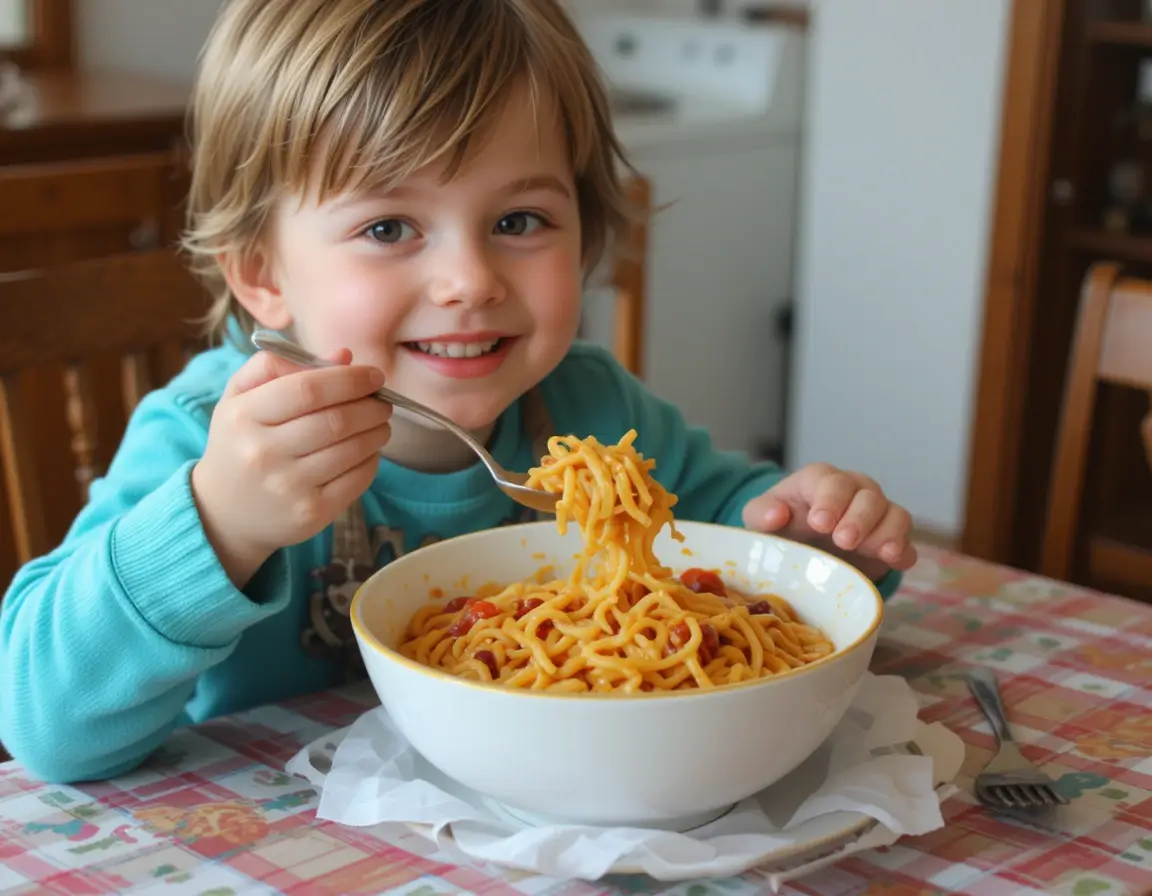
Pastina as a Childhood Staple
In many Italian homes, pastina isn’t just food—it’s a cherished memory. From a young age, children are introduced to this simple dish, often during times of illness or as a comforting meal. Its gentle texture and mild flavor make it ideal for young palates. Moreover, the act of preparing pastina becomes a bonding experience between generations, with recipes and techniques passed down from nonnas to grandchildren.
Symbol of Comfort and Care
Beyond its role in childhood, pastina serves as a symbol of love and care in Italian culture. It’s the go-to dish when someone is feeling under the weather or in need of comfort. The simplicity of the pastina recipe allows the focus to be on the act of nurturing, turning a basic meal into a heartfelt gesture. This cultural significance underscores why pastina remains a staple in Italian households, transcending its humble ingredients to become a dish rich in emotional value.
Nutritional Benefits of the Pastina Recipe
Healthful Aspects of Pastina
While pastina is often celebrated for its comfort, it also offers nutritional benefits. When prepared with a rich broth, it provides essential nutrients like proteins and minerals. Adding vegetables such as carrots, spinach, or peas enhances its vitamin content, making it a balanced meal. Furthermore, incorporating lean proteins like chicken or an egg can boost its protein profile, supporting muscle health and satiety.
Suitable for Various Dietary Needs
The versatility of the pastina recipe allows it to cater to different dietary requirements. For those seeking gluten-free options, gluten-free pastina varieties are available. Vegetarians can opt for vegetable broth and omit animal-based additions. Moreover, by controlling the amount of added salt and butter, the dish can be tailored for low-sodium or low-fat diets. This adaptability ensures that pastina remains a nourishing option for a wide range of individuals.
Tips and Tricks for Perfecting Your Pastina Recipe
Achieving the Ideal Consistency
The key to a perfect pastina lies in its consistency. For a soupier texture, increase the amount of broth and reduce cooking time slightly. Conversely, for a thicker, risotto-like consistency, allow the pastina to absorb more liquid during cooking. Stirring continuously ensures even cooking and prevents sticking, resulting in a creamy, cohesive dish.
Enhancing Flavor Profiles
While the traditional pastina recipe is delightful in its simplicity, there are ways to elevate its flavor. Sautéing garlic or onions before adding the broth can introduce aromatic depth. Incorporating herbs like basil or parsley adds freshness, while a dash of lemon zest can provide a bright contrast. Experimenting with different cheeses, such as Pecorino Romano or Asiago, can also offer new taste dimensions, allowing you to customize the dish to your preferences.
Frequently Asked Questions About the Pastina Recipe
Can I Use Water Instead of Broth in a Pastina Recipe?
Yes, you can use water; however, broth adds depth and flavor to the dish. If opting for water, consider enhancing the taste with herbs, spices, or a bouillon cube.
Is Pastina Suitable for Babies?
Absolutely. The soft texture and small size make it ideal for infants. Ensure it’s cooked thoroughly and avoid adding salt or strong spices.
How Can I Make a Gluten-Free Pastina Recipe?
Look for gluten-free pastina varieties made from rice or corn. Brands like Barilla offer gluten-free options that work well in traditional recipes.
Can I Add Protein to My Pastina Recipe?
Certainly. Adding shredded chicken, a poached egg, or beans can boost the protein content, making the dish more filling and nutritious.
How Do I Store Leftover Pastina?
Store leftovers in an airtight container in the refrigerator for up to three days. Reheat gently on the stove or microwave, adding a splash of broth to restore creaminess.
Conclusion: The Enduring Charm of the Pastina Recipe
In exploring the pastina recipe, we’ve journeyed through its comforting simplicity, cultural significance, and nutritional benefits. This humble dish, often associated with childhood memories and familial warmth, exemplifies how food can transcend mere sustenance to become a symbol of love and tradition.
The pastina recipe stands as a testament to the idea that simplicity in cooking doesn’t equate to a lack of flavor or nourishment. Its versatility allows for adaptations to suit various dietary needs, making it accessible to many. Whether enriched with vegetables for added nutrients or customized with different broths and seasonings, pastina remains a dish that can be both comforting and healthful.
Culturally, pastina holds a special place in Italian households, often serving as a first solid food for children or a soothing meal during times of illness. Its preparation and consumption are imbued with care and affection, reinforcing familial bonds and preserving culinary traditions.
In today’s fast-paced world, the pastina recipe offers a reminder of the joys found in simple, home-cooked meals. It encourages us to slow down, savor the flavors, and appreciate the comfort that a warm bowl of pastina can provide. As we continue to explore diverse cuisines and complex recipes, it’s essential to remember and celebrate dishes like pastina that bring comfort, nutrition, and a sense of home.
Therefore, embracing the pastina recipe is not just about enjoying a meal; it’s about honoring a tradition that has nourished generations. It’s a culinary embrace that continues to warm hearts and homes, proving that sometimes, the simplest dishes leave the most lasting impressions.
For more delicious recipes, check out our Chicken Birria Tacos Recipe article.
